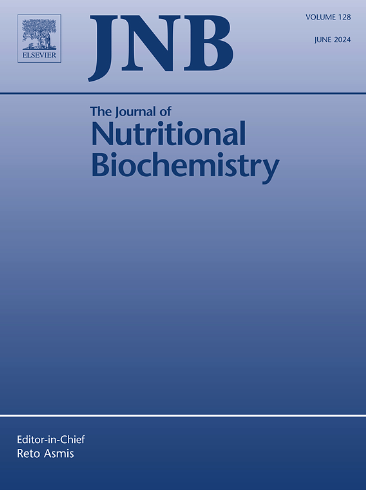Behavioral changes and transcriptional regulation of mesolimbic dopaminergic genes in a mouse model of binge eating disorder by diet intermittent access
IF 4.8
2区 医学
Q1 BIOCHEMISTRY & MOLECULAR BIOLOGY
引用次数: 0
Abstract
Binge Eating Disorder (BED) is among the most prevalent eating disorders worldwide. It is characterized by recurrent episodes of excessive consumption of palatable foods in short periods, accompanied by a sense of loss of control and distress around the episode, which tends to worsen over time. The mesolimbic dopaminergic system influences on reinforcement and reward-seeking behaviors is implicated in the disorder's pathogenesis. Animal models that replicate the clinical conditions observed in humans, including the disorder progression, are essential for understanding the underlying physiological mechanisms of BED. This study aimed to evaluate binge eating behavior induced by intermittent High Sugar and Butter (HSB) diet access in mice, their phenotypes, transcriptional regulation of mesolimbic dopaminergic system genes, and behavior. Thus, mice were subdivided into three groups: CHOW (maintenance diet only), HSB-i (maintenance diet with thrice-weekly access to HSB), and HSB (continuous access to HSB). Animals were subjected to marble-burying and light-dark box behavioral tests, and transcriptional regulation was evaluated by RT-qPCR. The results indicated that the HSB-i group established a feeding pattern of significantly more kilocalories on days when HSB was available and reduced intake on non-HSB days similar to human binge eating. Over time, binge episodes intensified, potentially indicating a tolerance effect. Additionally, these animals behave differently towards preferring the HSB diet and exhibited altered transcriptional regulation of the Drd1, Slc6a3, and Lrrk2 genes. Our study provides a mouse model that reflects human BED, showing a progression in binge episodes and mesolimbic dopamine pathway involvement, suggesting targets for future therapeutic interventions.
饮食间歇性接触暴饮暴食症小鼠模型的行为变化和间叶多巴胺能基因的转录调控。
暴饮暴食症(BED)是全球最普遍的饮食失调症之一。它的特点是反复发作,在短期内摄入过多适口食物,并伴有失控感和围绕发作的痛苦,这种情况往往会随着时间的推移而恶化。中边缘多巴胺能系统对强化和寻求奖赏行为的影响与该疾病的发病机制有关。复制人类临床症状(包括疾病进展)的动物模型对于了解暴食症的潜在生理机制至关重要。本研究旨在评估小鼠间歇性摄入高糖高黄油(HSB)饮食诱发的暴食行为、其表型、间叶多巴胺能系统基因的转录调控以及行为。因此,小鼠被细分为三组:CHOW(仅摄入维持性饮食)、HSB-i(摄入维持性饮食,每周三次摄入 HSB)和 HSB(持续摄入 HSB)。对动物进行埋大理石和光-暗箱行为测试,并通过 RT-qPCR 评估转录调控。结果表明,HSB-i 组建立了一种进食模式,即在有 HSB 的日子里摄入的热量显著增加,而在没有 HSB 的日子里摄入的热量则减少,这与人类的暴饮暴食类似。随着时间的推移,暴食现象会加剧,这可能表明存在耐受效应。此外,这些动物对 HSB 饮食的偏好表现不同,并表现出 Drd1、Slc6a3 和 Lrrk2 基因转录调控的改变。我们的研究提供了一个反映人类暴饮暴食症的小鼠模型,显示了暴饮暴食发作的进展和间叶多巴胺通路的参与,为未来的治疗干预提出了目标。
本文章由计算机程序翻译,如有差异,请以英文原文为准。
求助全文
约1分钟内获得全文
求助全文
来源期刊

Journal of Nutritional Biochemistry
医学-生化与分子生物学
CiteScore
9.50
自引率
3.60%
发文量
237
审稿时长
68 days
期刊介绍:
Devoted to advancements in nutritional sciences, The Journal of Nutritional Biochemistry presents experimental nutrition research as it relates to: biochemistry, molecular biology, toxicology, or physiology.
Rigorous reviews by an international editorial board of distinguished scientists ensure publication of the most current and key research being conducted in nutrition at the cellular, animal and human level. In addition to its monthly features of critical reviews and research articles, The Journal of Nutritional Biochemistry also periodically publishes emerging issues, experimental methods, and other types of articles.
 求助内容:
求助内容: 应助结果提醒方式:
应助结果提醒方式:


